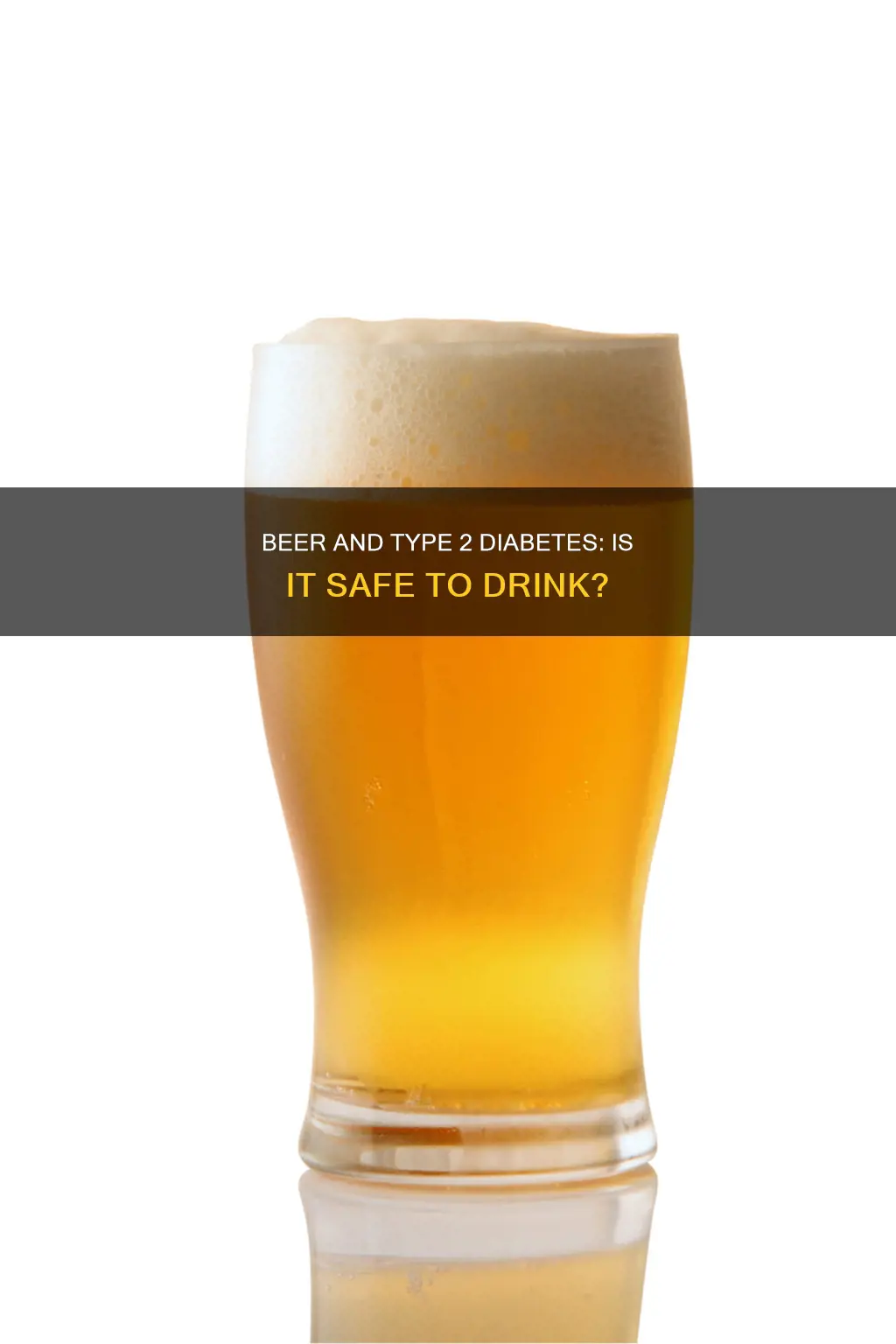
People with type 2 diabetes can usually drink alcohol in moderation, but there are some important considerations to keep in mind. Alcohol can affect blood sugar levels, and drinking can increase the risk of hypoglycaemia (low blood sugar). This is because the liver, which is responsible for stabilising glucose levels, prioritises metabolising alcohol over maintaining blood glucose. Drinking on an empty stomach or in excess can cause blood sugar to spike and then fall quickly, so it's important to eat a balanced meal before or while drinking. Alcohol can also affect weight, as it is often high in calories, and can interfere with diabetes medication. It's important to consult a doctor before drinking alcohol, as they can advise on how to drink safely.
| Characteristics | Values |
|---|---|
| Alcohol consumption for type 2 diabetics | In most cases, people with type 2 diabetes can drink alcohol in moderate amounts. |
| Alcohol's effect on blood sugar | Alcohol can lower blood sugar, but it can also increase it. |
| Alcohol's effect on cholesterol | Alcohol can increase "good" cholesterol (HDL) in the blood. |
| Alcohol's effect on weight | Alcohol can contribute to weight gain. |
| Alcohol's effect on medication | Alcohol can reduce the effectiveness of diabetes medication. |
| Alcohol's effect on health | Excessive alcohol consumption can lead to raised blood pressure, worsen neuropathy, cause dehydration and sleep disruption, and increase the risk of certain cancers and heart disease. |
| Safe alcohol consumption | It is recommended that women have no more than one drink per day and men no more than two drinks per day. |
| Safe blood sugar level | A healthy range is between 80 mg/dL and 130 mg/dL before bed. |
| Alcohol and food | It is recommended to drink alcohol with food, especially carbohydrates, to reduce the risk of hypoglycemia. |
| Alcohol and medication | Consult a doctor about how alcohol may affect your medication and whether dosage adjustments are needed. |
What You'll Learn

The impact of beer on blood sugar levels
Beer is not off-limits for people with type 2 diabetes, but it's important to be aware of how it can affect your body and take steps to manage this. Beer contains a moderate amount of carbohydrates and generally has 2-12% ABV (alcohol by volume). Lower ABV beers will have closer to 6 grams of carbs, while higher ABV beers may have as much as 20-30 grams per 12-ounce bottle. If you're drinking beer on tap and don't have the nutrition facts, sticking to beers with an ABV of 7% or less can help keep your carb intake in check.
The American Diabetes Association (ADA) recommends no more than one drink per day for women and up to two drinks per day for men. For beer, one drink is considered to be 12 ounces. It's a good idea to stick to a can or bottle, as these usually come in a 12-ounce size. If you're getting a draft beer, you can request a smaller size or be mindful of the extra 4 ounces.
When you drink on an empty stomach or in excess, the carbs in the beer can cause blood sugar to spike and then fall quickly, potentially causing hypoglycemia (dangerously low blood sugar). This effect is made worse by the fact that when you drink alcohol, your body prioritises getting rid of it, causing an interruption in blood sugar regulation. By eating a balanced meal that includes protein, fibre, and healthy fats, the alcohol in your beer is absorbed more slowly, keeping blood sugar more stable.
If you feel comfortable, let your friends know that you have diabetes and that hypoglycemia has similar symptoms to drinking too much (dizziness, confusion, lightheadedness). They can help keep an eye on you and ensure your safety if it appears that your blood sugar has dropped too low. If you are drinking with people who don't know you have diabetes, it is even more important to practice good self-care and prevent blood sugar highs and lows.
It's important to check your blood sugar more frequently when drinking beer. Staying within the blood sugar safe zone of 70-180 mg/dL is crucial. Check your blood sugar before, during, and up to 24 hours after drinking. Before going to bed, your blood sugar should be between 100-140 mg/dL. If your reading is below this, have a snack with carbs and protein to bring it up.
If you take insulin or insulin-stimulating medications, be extra cautious while drinking alcohol. These medications may need dosage adjustments when consuming alcohol. Consult your diabetes healthcare provider for guidance on how to adjust your medications, including insulin, on days you drink alcohol.
Beer and Health: A Daily Drink, Safe or Not?
You may want to see also

How much beer can type 2 diabetics drink
If you have type 2 diabetes, you may be wondering if it is safe to drink beer. The answer is yes, but with some important considerations in mind. Here are some guidelines and recommendations to help you understand how much beer you can drink if you have type 2 diabetes:
Effects of Alcohol on Type 2 Diabetes
Alcohol can affect your blood sugar levels and interfere with your diabetes management. When you drink alcohol, your liver prioritises breaking down the alcohol instead of releasing glucose, which can lead to a drop in blood sugar levels. This effect is more pronounced when drinking on an empty stomach, as the carbs in the beer can cause a rapid spike and then a fall in blood sugar levels, potentially leading to hypoglycaemia. Therefore, it is recommended to drink beer with a meal to slow down the absorption of alcohol and prevent blood sugar spikes.
Recommended Amounts
Moderate alcohol consumption is generally considered safe for people with type 2 diabetes. According to the Centers for Disease Control and Prevention (CDC), moderation means up to one drink per day for women and up to two drinks per day for men. One drink is equivalent to 12 fluid ounces of regular beer (5% alcohol). It is important to note that these guidelines are for the general population and may vary depending on your specific health condition and medications. Always consult your healthcare provider for personalised advice.
Choosing the Right Beer
Not all beers are created equal when it comes to diabetes. Beers with lower alcohol by volume (ABV) tend to have fewer carbs, with beers below 7% ABV containing around 6 grams of carbs per 12-ounce bottle. Low-carb beer options include Corona Premier, Michelob Ultra, and Coors Light. Checking the nutrition facts and choosing beers with lower ABVs can help you make more informed choices.
Monitoring and Management
It is crucial to closely monitor your blood sugar levels before, during, and up to 24 hours after drinking beer. Staying within a safe blood sugar zone, such as 70-180 mg/dL, is important. If your blood sugar levels drop below the recommended range, consume a snack with carbs and protein to bring them back up. Additionally, always wear a medical ID bracelet or necklace to ensure that others are aware of your diabetes in case of an emergency.
Medication Interactions
If you are taking insulin or diabetes medications, drinking beer may require dosage adjustments. Alcohol can interfere with the effectiveness of these medications, so it is essential to consult your healthcare provider for guidance on how to manage your medication and alcohol intake.
In summary, if you have type 2 diabetes, you can safely drink beer in moderation by following the recommended guidelines, choosing lower-carb options, monitoring your blood sugar levels, and consulting your healthcare team for personalised advice and medication adjustments.
Beer After Working Out: Good or Bad Idea?
You may want to see also

The best types of alcohol for type 2 diabetics
If you have type 2 diabetes, you can still enjoy an alcoholic drink, but it's important to be aware of how alcohol affects your body and how to manage this. Alcohol can interfere with your blood sugar levels, and there can be a lot of calories in alcoholic drinks, which can affect your weight. The key is to drink in moderation and to be aware of the risks involved. Here are some tips to help you choose the best types of alcohol if you have type 2 diabetes:
- Stick to the recommended guidelines: The recommended amount is one drink per day for women and up to two per day for men. One drink is defined as 12 fluid ounces of regular beer, five fluid ounces of wine, or 1.5 fluid ounces of 80-proof spirits.
- Choose low-carb and low-sugar options: Opt for "light" or "low-carb" beers, which have fewer carbohydrates and calories than regular beer. Avoid sweet wines, such as dessert wines and flavoured wines, as these contain more sugar.
- Mix spirits with diet or sugar-free mixers: Spirits like vodka, rum, and whiskey are often carb-free, but be mindful of what you mix them with. Mixers like soda and juice can cause a spike in blood sugar levels. Instead, opt for calorie-free mixers like water, seltzer, or diet soda.
- Be cautious with craft beers: Craft beers often have twice the alcohol and calories as regular beer, so be mindful of how much you're consuming.
- Red or white wine in moderation: Wine, particularly red wine, may offer some health benefits, such as improving your body's ability to use insulin and reducing your risk of heart disease. However, moderation is key, as too much alcohol can lead to hypoglycemia.
- Avoid low-alcohol wines: These wines often have more sugar than regular wines. If you choose to drink them, stick to one or two glasses.
- Be aware of the risks: Excessive alcohol intake is associated with an increased risk of type 2 diabetes and can lead to raised blood pressure, nerve damage, dehydration, sleep disturbances, and an increased risk of certain cancers and heart disease.
- Talk to your doctor: Drinking is individualized, and there is no one-size-fits-all approach. Discuss your drinking habits with your doctor, and they can provide you with personalised tips and tricks for drinking safely.
Underage Beer Drinking: What's the Deal?
You may want to see also

Alcohol's effect on diabetes medication
When it comes to managing type 2 diabetes, it's important to understand the impact that alcohol can have on your medication and overall blood sugar control. Alcohol can affect diabetes medication in several ways, and it's crucial for individuals with type 2 diabetes to be aware of these interactions to make informed choices and maintain stable blood glucose levels. Here are some key points to consider regarding alcohol's effect on diabetes medication:
The interaction between alcohol and diabetes medications can vary depending on the type of medication being used. For example, insulin and sulfonylureas, which are commonly used to treat type 2 diabetes, can interact with alcohol in different ways. Alcohol may increase the risk of hypoglycemia (low blood sugar) in individuals taking insulin or sulfonylureas, as it can block the liver's ability to release glucose, causing a rapid drop in blood sugar levels. Therefore, it is generally recommended that individuals taking these medications limit their alcohol intake and always consume alcohol with food to reduce the risk of hypoglycemic episodes.
Additionally, alcohol can affect how certain diabetes medications are metabolized in the body. For example, metformin, another common type 2 diabetes medication, is primarily eliminated by the kidneys. Drinking excessive amounts of alcohol can impair kidney function and affect the elimination of metformin, potentially leading to a buildup of the drug in the body. This can increase the risk of side effects such as lactic acidosis, a serious condition that requires immediate medical attention.
It's important to note that alcohol itself can affect blood sugar levels independently of medication interactions. Alcoholic beverages, especially those high in sugar content, can cause blood sugar spikes, especially when consumed on an empty stomach. On the other hand, excessive alcohol intake without proper food intake can lead to hypoglycemia, as alcohol interferes with the body's ability to release glucose. These fluctuations in blood sugar levels can be challenging for individuals with type 2 diabetes to manage, especially if they are trying to maintain tight glycemic control.
Finally, it's worth mentioning that diabetes management often involves lifestyle modifications, including dietary and exercise habits. Alcoholic beverages are typically high in calories and low in nutritional value, which can undermine weight loss efforts, a crucial aspect of managing type 2 diabetes. Additionally, excessive alcohol consumption can lead to increased insulin resistance, making it harder for diabetes medications to control blood sugar effectively. Therefore, it is generally recommended that individuals with type 2 diabetes limit their alcohol intake and always consult their healthcare provider or diabetes educator for personalized advice regarding safe consumption guidelines.
Beer Consumption and LDL Levels: A Concerning Link
You may want to see also

How to drink beer safely with type 2 diabetes
If you have type 2 diabetes, you may be wondering if it is safe to drink beer. The answer is yes, but there are some important things you need to keep in mind to ensure you are drinking beer safely. Here are some guidelines to help you drink beer in a way that won't compromise your health:
Understand the Risks
Firstly, it is important to understand the risks associated with drinking alcohol when you have type 2 diabetes. Alcohol can affect your blood sugar levels and cause them to drop to dangerously low levels, a condition known as hypoglycemia. This can lead to symptoms such as headaches, irregular heartbeat, anxiety, and confusion. Alcohol can also increase your weight, as alcoholic drinks tend to be high in calories. Additionally, alcohol may interfere with the effectiveness of your diabetes medication and affect your liver's ability to regulate blood sugar.
Drink in Moderation
If you choose to drink beer, it is crucial to do so in moderation. The general guideline is no more than one drink per day for women and up to two drinks per day for men. For beer, one drink is typically considered to be 12 ounces. It is recommended to stick to low-carb beers, as they have fewer calories and can help you maintain better blood sugar control.
Pair with Food
Always drink beer with a meal or a snack. Drinking on an empty stomach can cause blood sugar spikes and increase the risk of hypoglycemia. A balanced meal with protein, fibre, and healthy fats will help slow the absorption of alcohol and keep your blood sugar levels more stable.
Monitor Blood Sugar Levels
Frequently check your blood sugar levels before, during, and up to 24 hours after drinking. This will help you stay within the safe zone, which is typically considered to be between 70-180 mg/dL. If your blood sugar levels drop too low, consume a snack with carbohydrates and protein to bring them back up.
Be Mindful of Medication
If you are taking insulin or diabetes medication, be cautious and consult your healthcare provider about adjusting your dosage when consuming alcohol. Alcohol can interfere with the effectiveness of your medication, so it is important to be extra vigilant about monitoring your blood sugar levels and making any necessary adjustments.
Know the Symptoms
Be aware of the symptoms of hypoglycemia, as they can sometimes be confused with or masked by the effects of alcohol. These symptoms include dizziness, confusion, lightheadedness, flushing, nausea, increased heart rate, and slurred speech. Let your friends know about your diabetes and the similarities between hypoglycemia and drunkenness so they can help you if your blood sugar drops too low.
Choose Lower ABV Beers
Beers with lower alcohol by volume (ABV) tend to have fewer carbs, so opting for these can help you keep your carb intake in check. Beers with an ABV of 7% or less are generally a good choice, and there are several low-carb beer options available.
In conclusion, while it is generally safe for people with type 2 diabetes to drink beer, it is important to follow these guidelines to ensure you are doing so safely and minimising any potential risks to your health. Always consult your healthcare provider for personalised advice and to determine if drinking beer is appropriate for your specific situation.
Great Wolf Lodge: Beer Drinking Rules Explained
You may want to see also
Frequently asked questions
Yes, type 2 diabetics can drink beer, but they need to be mindful of how it affects their body and how to manage it. It is recommended to have a meal with your beer to slow down the absorption of alcohol and prevent blood sugar spikes. It is also important to check blood sugar levels before, during, and up to 24 hours after drinking.
Drinking beer can affect blood sugar levels and increase the risk of hypoglycemia, especially if consumed on an empty stomach or in excess. It can also interfere with diabetes medications, increase weight gain, and affect physical health.
It is recommended to drink in moderation, choose low-carb and low-sugar beers, and always consume alcohol with food to prevent blood sugar spikes and hypoglycemia. It is also important to monitor blood sugar levels regularly and consult a healthcare professional for personalised advice.







